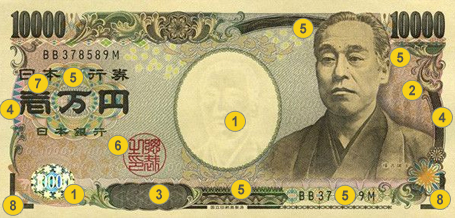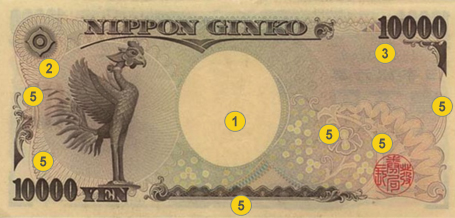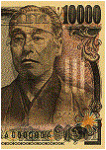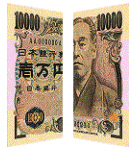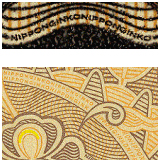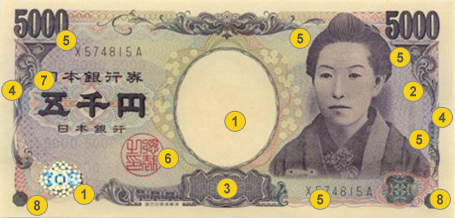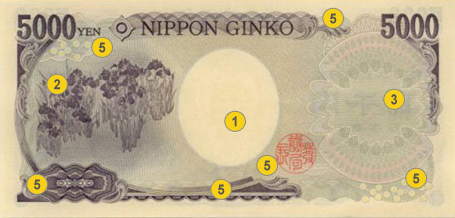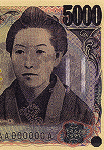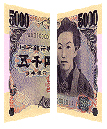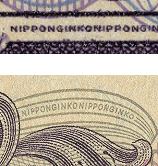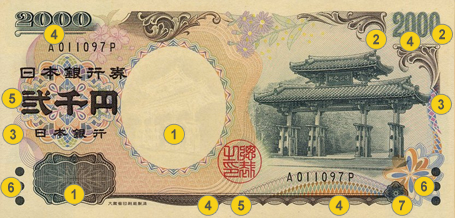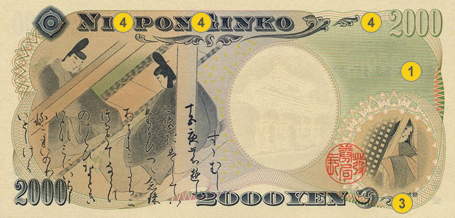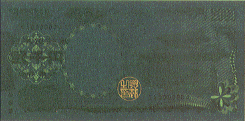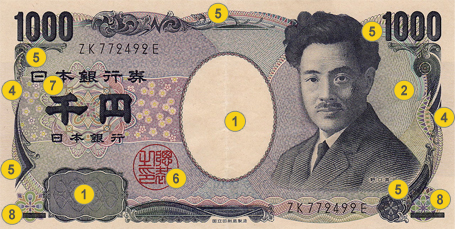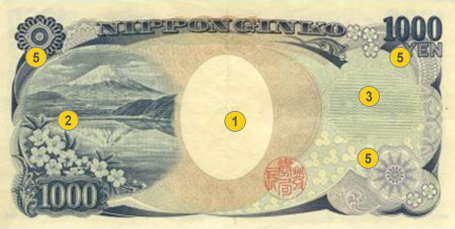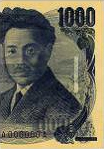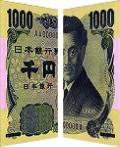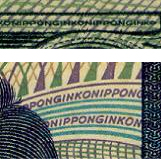The Japanese Yen security features
There are currently four different denominations of Japanese Yen notes in circulation. 4 different banknotes in different values and sizes: ¥1,000, ¥2,000, ¥5,000 and ¥10,000. Japanese Yen is the legal and official currency of Japan.
"Touch-and-Tell" Features for Identifying the Denominations of Bank of Japan Notes. Each banknote has security feature of Tactile marks (intaglio printing). On 5,000 and 10,000 banknotes you'll find Hologram transparent layer security feature.
Each denomination has different banknote lengths: 10,000 yen note 160 mm, 5,000 yen note, the 2,000 yen note 154 mm, 1,000 yen note 150 mm.
Security features will help you to identify genuine banknotes. Take your time to check your notes, particularly if light conditions are poor or you are handling a large number of notes. Look at Japanese Yen's security features described below.
All Japanese yen banknotes: ¥5, ¥10, ¥20, ¥10,000 security features in detail
- 10,000 Japanese yen banknote
- 5,000 Japanese yen banknote
- 2,000 Japanese yen banknote
- 1,000 Japanese yen banknote
¥10,000 Japanese yen banknote security features. Recognize your 10,000 Japanese yen banknote is not fake, spot a fake banknote
On front side of ¥10,000 note you will see Yukichi Fukuzawa (a Meiji era philosopher and the founder of Keio University). On the back of the note - Statue of Phoenix in Byodoin Temple. Size of banknote: 160x76mm.
¥10,000 Japanese yen Issued 2004 - Present
|
10,000 Japanese yen banknote. Front. 10,000 Japanese yen banknote. Back. |
1) Hologram. When the banknote is tilted, the color and pattern of the design change. 2) Watermark-bar-pattern. When the banknote is held up to the light, three vertical watermark bars (two bars for the 5,000 yen note, one for the 1,000 yen note) become visible. This feature is more difficult to reproduce with personal computers or color copiers than the traditional watermark. 3) Latent image. When the banknote is viewed from a certain angle, the number "10000"appears on the bottom left of the front side, and the word "NIPPON" ("Japan" in Japanese) on the top right of the back side. 4) Pearl ink. When viewed from different angles, a semi-transparent pattern printed with pink pearl ink appears in the blank areas of the left and right margins of the front of the note. 5) Microprinting. Like notes issued since December 1, 1993 (with serial numbers in brown), the new 10,000 yen note has the words "NIPPON GINKO" ("Bank of Japan" in Japanese) printed in micro letters. Some of the micro letters are made even smaller on the new note than those on the current note. Also, micro letters of different sizes are included in the background design. 6) Luminescent ink. As in notes issued since December 1, 1993 (with serial numbers in brown), the Governor's seal on the front side glows orange under ultraviolet light. Likewise, some parts of the background pattern fluoresce yellowish-green. 7) Intaglio printing. Raised printing is used for some features of the new note. The ink on the new note is raised higher than the ink on the current note. 8) Tactile marks (intaglio printing). To assist the visually impaired in detecting the note by touch, a recognition symbol with a rougher texture, printed intaglio, is adopted instead of the watermark symbols used for the current note. |
¥5,000 Japanese yen banknote security features. Recognize your 5,000 Japanese yen banknote is not fake, spot a fake banknote
On front side of ¥5,000 note you will see Ichiyo Higuchi, a Meiji era writer and poet. On the back of the note - "Kakitsubata-zu" (painting of irises), Work of Korin Ogata. Size of banknote: 156x76mm.
¥5,000 Japanese yen Issued 2004 - Present
|
5,000 Japanese yen banknote. Front. 5,000 Japanese yen banknote. Back. |
1) Hologram. When the banknote is tilted, the color and pattern of the design change. 2) Watermark-bar-pattern.. When the banknote is held up to the light, two vertical watermark bars (three bars for the 10,000 yen note, one for the 1,000 yen note) become visible. This feature is more difficult to reproduce with personal computers or color copiers than the traditional watermark. 3) Latent image. When the banknote is viewed from a certain angle, the number "5000"appears on the center bottom of the front side, and the word "NIPPON" ("Japan" in Japanese) on the right in the middle of the back side. 4) Pearl ink. When viewed from different angles, a semi-transparent pattern printed with pink pearl ink appears in the blank areas of the left and right margins of the front of the note. 5) Microprinting. Like notes issued since December 1, 1993 (with serial numbers in brown), the new 5,000 yen note has the words "NIPPON GINKO" ("Bank of Japan" in Japanese) printed in micro letters. Some of the micro letters are made even smaller on the new note than those on the current note. Also, micro letters of different sizes are included in the background design. 6) Luminescent ink. As in notes issued since December 1, 1993 (with serial numbers in brown), the Governor's seal on the front side glows orange under ultraviolet light. Likewise, some parts of the background pattern fluoresce yellowish-green. 7) Intaglio printing. Raised printing is used for some features of the new note. The ink on the new note is raised higher than the ink on the current note. 8) Tactile marks (intaglio printing). To assist the visually impaired in detecting the note by touch, a recognition symbol with a rougher texture, printed intaglio, is adopted instead of the watermark symbols used for the current note. |
¥2,000 Japanese yen banknote security features. Recognize your 2,000 Japanese yen banknote is not fake, spot a fake banknote
On front side of ¥2,000 note you will see Shureimon, a 16th-century gate at Shuri Castle in Naha, in Okinawa Prefecture, Japan. On the back of the note - a scene from The Tale of Genji, and a portrait of Murasaki Shikibu, the noblewoman to whom this work of classic literature has been attributed. Size of banknote: 154x76mm.
¥2,000 JPY Note issued 2000 - Present.
|
2,000 Japanese yen banknote. Front. 2,000 Japanese yen banknote. Back. |
1) Latent image. When the banknote is viewed from a certain angle, the number "2000" appears on the bottom left of the front side, and the word "NIPPON" ("Japan" in Japanese) on the top right of the back side. 2) Color-shifting ink.. The number "2000" on the front top right-hand corner changes its color from bluish-green to purple when viewed from different angles. 3) Pearl ink. When viewed from different angles, a semi-transparent pattern printed with pink pearl ink appears in the blank areas of the left and right margins of the front of the note. 4) Microprinting. Like notes issued since December 1, 1993, the 2,000 yen note has the words "NIPPON GINKO" ("Bank of Japan" in Japanese) printed in micro letters. The micro letters printed intaglio are smaller on the 2,000 yen note than those on existing denominations. Also, with the use of background printing, micro letters of different sizes forming curved lines have been introduced. 5) Intaglio printing. The ink of the Chinese characters showing the denomination and the picture of the Shurei-mon Gate is raised higher from the surface of the paper than that on other banknotes. This gives the banknote's surface a rough feeling, thus making it easy to distinguish from other denominations. 6) To assist the visually impaired in detecting the 2,000 yen note by touch, a recognition symbol with a rougher texture, printed intaglio, is adopted instead of the watermark symbols used for other notes. 7) Luminescent ink. As in notes issued since December 1, 1993, the Governor's seal on the front side glows orange under ultraviolet light. Likewise, the blue parts of the background pattern fluoresce yellowish-green. |
¥1,000 Japanese yen banknote security features. Recognize your 1,000 Japanese yen banknote is not fake, spot a fake banknote
On front side of ¥1,000 note you will see a portrait of Hideyo Noguchi, who in 1911 discovered the agent of syphilis as the cause of progressive paralytic disease. On the back of the note - Mount Fuji and cherry blossoms, adapted from a photograph by Koyo Okada. Size of banknote: 150x76mm.
¥1,000 JPY banknote issued 2004 - Present.
|
1,000 Japanese yen banknote. Front. 1,000 Japanese yen banknote. Back. |
1) Latent pearl image. A security feature unique to the new 1,000 yen note. When the banknote is tilted, you can see (1) the Japanese characters meaning "1,000 yen" printed with pearl ink, and (2) the number "1000" as a latent image. 2) Watermark-bar-pattern.. When the banknote is held up to the light, a vertical watermark bar (three bars for the 10,000 yen note, two for the 5,000 yen note) becomes visible. This feature is more difficult to reproduce with personal computers or color copiers than the traditional watermark. 3) Latent image. When the banknote is viewed from a certain angle, the word "NIPPON" ("Japan" in Japanese) appears on the top right of the back side. 4) Pearl ink. When viewed from different angles, a semi-transparent pattern printed with pink pearl ink appears in the blank areas of the left and right margins of the front of the note. 5) Microprinting. Like notes issued since December 1, 1993 (with serial numbers in brown or dark green), the new 1,000 yen note has the words "NIPPON GINKO" ("Bank of Japan" in Japanese) printed in micro letters. Some of the micro letters are made even smaller on the new note than those on the current note. Also, micro letters of different sizes are included in the background design. 6) Luminescent ink. As in notes issued since December 1, 1993 (with serial numbers in brown or dark green), the Governor's seal on the front side glows orange under ultraviolet light. Likewise, some parts of the background pattern fluoresce yellowish-green. 7) Intaglio printing. Raised printing is used for some features of the new note. The ink on the new note is raised higher than the ink on the current note. 8) Tactile marks (intaglio printing). To assist the visually impaired in detecting the note by touch, a recognition symbol with a rougher texture, printed intaglio, is adopted instead of the watermark symbols used for the current note. |
